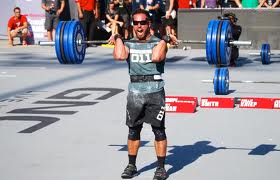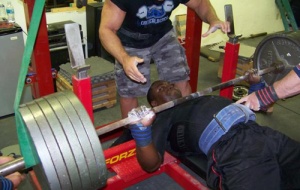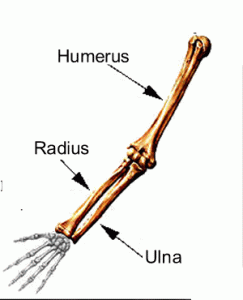![overhead-squat[1]](https://allgofitnessblog.wordpress.com/wp-content/uploads/2013/03/overhead-squat1.jpg?w=300&h=153)
The overhead squat is, in my opinion, one of the most challenging non-Olympic lifting barbell lifts which you can do. It requires a ton of mobility in several different regions of the body, as well as a ton of core strength and overhead stability. For those of you who are unfamiliar with the overhead squat, check out this video below.
Perhaps the first question which needs answering is: do you even need to overhead squat? I had this debate with an Olympic lifter friend of mine. His argument was that overhead squatting is unnecessary because the movement is covered when you snatch. I still felt the overhead squat was an important exercise to help create core and overhead stability. It took my thick head a couple of days to realize why we had differing viewpoints: he squat snatches, while I mostly power snatch. As a result, he gets a lot of full range overhead squatting in from his snatching, whereas I do not. This would explain in part why I struggle with the overhead squat: I haven’t really done it much.
Long story short, if you do a lot of squat snatching, you probably don’t need to program heavy overhead squats into your routine. If you mostly power snatch, I’d recommend programming in overhead squats to get you comfortable in the bottom position. And just to throw a little common sense at you: unless you are a CrossFitter training the overhead squat for its own sake, or an Olympic lifter training the overhead squat for snatching with a belt on, ditch the weight belt. Doing an exercise like this which demands a lot of your core with a belt on doesn’t make much sense.
What Does The Overhead Squat Do?
Believe it or not, the overhead squat, for most people, is not going to do a ton to build up lower body strength/power. Think of it this way. Let’s say you can back squat 300# for 3 reps, and overhead squat 250# for 3 reps. In both movements, your legs are displacing the same amount of weight. Since you can presumably overhead squat less than you can back or front squat, your legs will not be challenged in the same way that they would be if you back or front squatted.
The overhead squat is GREAT for core stability, upper back strengthing, mobility (especially when done lightly with an emphasis on perfect technique), and assessment purposes. If you want to see what’s wrong with a person’s body mobility-wise, watch them overhead squat.
As a bit of an aside, if you have never done the overhead squat, it may look like it requires a lot of tricep strength. While the triceps might be needed to press the weight into an overhead position, your elbows should be locked out when overhead squatting. There should be NO bend. If you find your triceps working a lot, you are probably doing the movement wrong.
Am I Ready To Overhead Squat?
Here is a guideline which I would suggest. Ever heard of the behind-the-neck Sots press? See the video below. If you can do this exercise properly and pain free with an empty Olympic bar, you PROBABLY (and remember, I’m not a doctor) have the mobility and shoulder health required to overhead squat.
My Sots Press Was Laughable. How Can I Get To The Point Of Overhead Squatting?
There are a number of things which can cause a poor Sots press. If you are an athlete and have been training using even moderately good programming and full range of motion, I’m going to go ahead and assume core stability and upper back/shoulder strength are likely not the reason your Sots press looks like you are bowing. Chances are the culprit is poor mobility.
If your torso inclines forward, you may have poor ankle mobility (focus on soleus and heel cord) or poor hip mobility (focus on piriformis, glutes, hams, etc.).
If you have pain in the knees or hips you probably have poor mobility in the knees or hips. Pretty self explanatory.
If you cannot push the bar straight up overhead, chances are one or several of the following areas need mobility work: upper traps, lats, pec minor, thoracic.
While I’m not going to go into how to fix all of those problems, check out the video below from Kelly Starrett which has some good overhead squat warm-up/solution info.
I’m Good To Start Overhead Squatting. How Do I Incorporate It Into My Programming?
Since this movement demands a lot of the core and a little bit less of the legs, I would definitely suggest doing it closer to the end of your workout. You definitely want to get your Olympic lifting and heavy squatting in first. Essentially, I would categorize this lift as an accessory movement. Don’t make it the focus of a workout.
I would not suggest going much above 6 reps per set on this exercise. It is a very complex movement that requires a lot of neural drive. High rep it, and small muscles like the ones in the upper back will start to fail, thus causing poor mechanics and increasing risk of injury.
The overhead squat is also a great warm-up for snatching. As well, as I mentioned earlier, it is a great assessment tool.
In Closing…
The overhead squat is an excellent exercise for any athlete who is not squat snatching. However, if you don’t respect how difficult and demanding it is and just try to jump into it, you are likely to hurt yourself. Check out your Sots press, and if you have issues which need some attention, fix them. Once you are ready to overhead squat, definitely consider making it a regular part of your routine. #allgo






